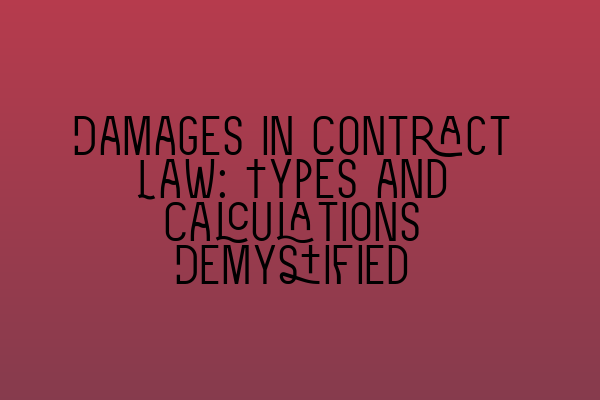Damages in Contract Law: Types and Calculations Demystified
In contract law, damages refer to the monetary compensation awarded to a party who has suffered a breach of contract by the other party. The purpose of damages is to place the injured party in the same position they would have been in had the contract been performed correctly. Understanding the different types of damages and their calculations can help parties navigate the complexities of contract law and seek appropriate redress for their losses.
Types of Damages
1. Compensatory Damages: These are the most common type of damages awarded in contract law. Compensatory damages aim to put the non-breaching party in the position they would have been in if the contract had been fully performed. They are calculated by assessing the actual loss suffered by the party, including any foreseeable consequential damages. This can include direct financial losses, such as lost profits, as well as indirect losses, such as reputational damage.
2. Expectation Damages: Expectation damages are a subset of compensatory damages and are based on the party’s expectation of what they would have gained from the contract. They are calculated by taking into account the value of the performance promised in the contract and any foreseeable consequential damages. These damages aim to place the non-breaching party in the position they would have been in if the contract had been performed as promised.
3. Restitution Damages: Restitution damages focus on restoring the non-breaching party to the position they were in before the contract was entered into. These damages aim to prevent unjust enrichment by the breaching party. They are calculated by assessing the value of any benefits received by the breaching party as a result of the contract.
4. Liquidated Damages: In some contracts, the parties may agree in advance to a predetermined amount of damages in the event of a breach. These are known as liquidated damages and are enforceable if they represent a reasonable estimate of the anticipated harm caused by the breach. It is important to note that liquidated damages cannot be used as a penalty for breaching the contract.
5. Nominal Damages: Nominal damages are awarded when there has been a breach of contract, but the non-breaching party has not suffered any actual financial loss. These damages are often symbolic in nature, serving as an acknowledgment of the breach rather than providing substantial compensation.
Calculating Damages
To calculate damages, various factors need to be considered, including:
1. Direct Financial Losses: This includes any financial harm resulting from the breach, such as lost profits, unpaid invoices, or additional costs incurred.
2. Consequential Damages: Consequential damages are those that arise as a result of the breach but are not directly caused by it. These damages can include lost business opportunities, reputational damage, or additional expenses incurred as a result of the breach.
3. Mitigation: The non-breaching party has a duty to mitigate their losses by taking reasonable steps to minimize the damage caused by the breach. Failure to mitigate can reduce the amount of damages awarded.
4. Foreseeability: Damages are only awarded for losses that were reasonably foreseeable at the time the contract was made. If the breaching party could not have reasonably foreseen the specific type of loss, they may not be held liable for it.
Conclusion
Understanding the types of damages available in contract law and the calculations involved is crucial for parties seeking compensation for a breach of contract. Compensatory damages, expectation damages, restitution damages, liquidated damages, and nominal damages each serve different purposes and are awarded based on the specific circumstances of the breach. By considering factors such as direct financial losses, consequential damages, mitigation, and foreseeability, parties can better navigate the complexities of contract law and seek appropriate redress for their losses.
Related Articles:
– Mentorship for Aspiring Solicitors: Nurturing Talent in the Legal Field
– Legal Challenges and Pitfalls: Navigating the Complexities of the Legal System
– The Benefits of Becoming a Solicitor: A Rewarding Career
– Law School in the UK: Your Guide to Starting Your Legal Journey
– Striking a Balance: Work-Life Harmony in the Legal Field
